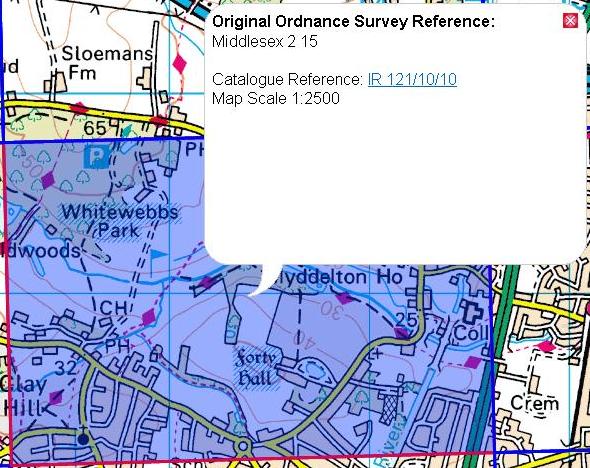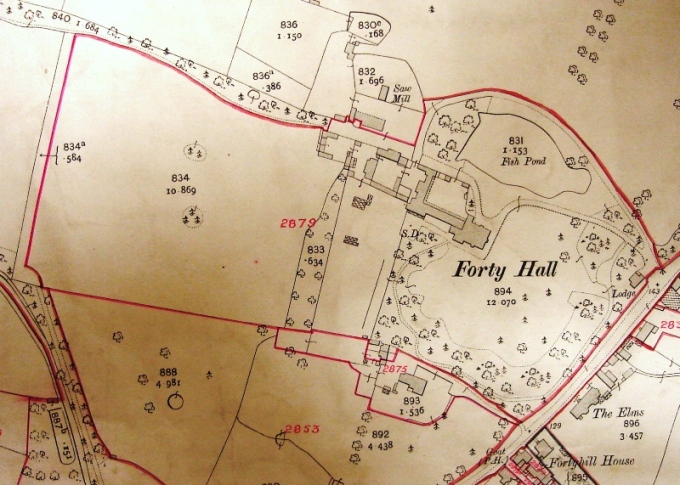
Forty Hall, Enfield: a very fine house indeed
I wish this was my house but, sadly, it isn’t. It’s Forty Hall, a Grade I listed manor house now owned by the London Borough of Enfield. It was originally built in the early 17th century for Sir Nicholas Rainton, a leading haberdasher who later served as Lord Mayor of London. The house has been a museum since 1951 and recently re-opened following a complete renovation and refurbishment.
I thought it would be interesting to find something about Forty Hall among our records so I decided to look it up in the Valuation Office survey. This survey was carried out in the years leading up to the First World War to assess the base rate for a new property tax called increment value duty, which had been introduced under the Finance (1909-10) Act 1910. Although increment value duty proved controversial and the legislation was repealed in 1920, 1 the surviving records of the survey now have a second ‘life’ in the archives. They are now one of the most popular sources for house history and local history, and are often used by family historians and professional researchers too.
Finding Forty Hall in the survey was a two-stage process. Firstly, I had to identify the relevant map among the records of the survey. These are printed Ordnance Survey maps annotated by hand to form an index to the related field books. Secondly, I had to use the plot number I had found on the map to look up the field book entry containing the details of the individual property.
To find the map, I went to the Valuation Office map finder tool in the Labs section of our website. I searched for the place-name Enfield and clicked to select the map sheet that includes Forty Hall, which is Ordnance Survey 1:2,500 County Series sheet Middlesex II 15. 2

Using the Valuation Office map finder
The maps themselves are not available online, so I made a note of the relevant document reference (which is IR 121/10/10) and placed an order to view the original map in our reading rooms. When it arrived, I looked for the handwritten plot number for Forty Hall, which turned out to be 2879.

The plot numbers are normally handwritten on the maps in red ink. (Detail from IR 121/10/10)
Knowing that each field book normally includes 100 properties, I searched Discovery, our catalogue, for the one covering Enfield plots 2801-2900. 3 This proved to be IR 58/29943. I placed an order for this to come to our reading rooms and, when it arrived, I turned to entry number 2879.
The entry dates from 18 July 1913 and names the occupier as Colonel H F Bowles and the freehold owner as H C B Bowles. The yearly rent is noted as just £1, obviously far less than the market rate. This, coupled with the fact that the tenant and landlord share the same surname, suggests that they were related and that the rent was only a token gesture. A description of the property, consisting mainly of a list of the rooms, reveals that there were three separate WCs.

As well as the conventional dining, drawing and smoking rooms, the ground floor of the house includes an intriguing ‘pillar’ room. (Detail from IR 58/29943 entry 2879)
Much of the rest of the entry is concerned with calculating Forty Hall’s taxable value. There is a note that the whole estate (apparently including several areas that were assessed by the Valuation Office as separate plots) had been sold in 1896 for a little over £21,000, and another £8,000 had been spent on improving it. Coincidentally, £8,000 was also what the house and its immediate grounds were judged to be worth in 1913, although only £3,000-worth of this was actually liable for increment value duty under the complicated assessment rules.
It’s always worth comparing Valuation Office records with the 1911 census, as the two sources are very close in date and often include complementary or overlapping information. When I looked up the census form for Forty Hall, I found that, although the address page names Colonel Bowles as the head of the family, he was not at home on census night. 4 The only named occupants are five servants, including a young butler, William Batten, who completed the form in his employer’s absence. I did, however, find a Henry Carington Bowles Bowles, aged 80, living nearby at Myddleton House with his wife, a grown-up son (Edward Augustus Bowles) and servants. 5

William Batten, the butler, originally made a mistake on the census form and listed himself as 'Head' of the household. (Detail from RG 14/7421 schedule 68.)
To learn more about H F Bowles I turned to a published source, David Pam’s three-volume History of Enfield. This confirms that Henry Carington Bowles Bowles purchased the estate for his elder son, Henry Ferryman Bowles, after its previous owner had died. 6 The house was extensively altered before the younger Henry and his family moved in, which explains what happened to some of the £8,000 recorded in the field book as spent on improvements. 7 I also learnt that the younger Henry Bowles had served as Enfield’s MP between 1889 and 1906. 8 He was to be re-elected to Parliament after the First World War and later became a baronet.

The occupier, Colonel Henry Ferryman Bowles, and the owner, his father Henry Carington Bowles Bowles. (Detail from IR 58/29943 entry 2879)
There is always a lot more to be said about the history of a house and its residents than can be squeezed into a single blog post. I hope to use future posts to explore further records relating to Forty Hall or some of its inhabitants.
What next?
Start your own research by looking at our brief online guide to researching houses and our in-depth guide on the Valuation Office survey.
Find out more about researching historic buildings on the Building History website.
Read Researching London’s Houses, by Colin Thom (available from The National Archives’ bookshop).
Notes:
- 1. If you are interested in the historical context of the survey, you might like to read Brian Short, Land and Society in Edwardian Britain (Cambridge, 1997). ↩
- 2. I was lucky and identified the right map sheet straightaway. Sometimes, especially in more densely-populated areas, you have to try two or three maps before finding the correct one. ↩
- 3. For my search, I typed in Enfield AND “IR 58” AND 2801. Once again, I was lucky and could identify the right field book on my first try. It isn’t always quite so straightforward. ↩
- 4. Document reference: RG 14/7421 schedule 68. ↩
- 5. Document reference: RG 14/7421 schedule 49. ↩
- 6. David Pam, A History of Enfield Volume 2 – 1837-1914: A Victorian Suburb (Enfield, 1992), p 50. ↩
- 7. The recent refurbishment has reversed many of the Bowles family’s alterations. ↩
- 8. Pam, pp 346-347. ↩

I have always had a fascination for the history behind a building, having had the privilege of growing up in older building myself, knowing that there were numerous families having lived there before all with different lifestyles yet all linked together by the same building. Unearthing a small newspaper clipping or some artefact make it ever more real. My chosen career has led me to become an estate agents , as fascinating as it is selling property, the history of a house is more rewarding. Doing speculative research can produce a wealth of information all be it on a small lodge that maybe the only building left standing. However with the correct research this can take you back hundreds of years of archived data to the original estate that is now long gone.
Really interesting article. My 4th Great Uncle Robert Hills worked at Forty Hill for thirty years from 1861 to 1891. I feel quite proud of him as he was son of a farmer at a place called Cold Hill Farm in Yorkshire and seems to have worked his way up in life. He was working as a footman aged 19 in Adwick Le Street for a JP. He moved to St George Hanover Square, Middlesex and married in Marylebone, listed as a butler aged 29. Robert moved to Forty Hill with his wife Susannah starting as a man servant and becoming butler by 1866 where he remained until his death in 1901. He seems to have lived at the Lodge, Forty Hall with his family. Robert’s daughter Alice gave birth to her son Aubrey as a single woman in 1888. Aubrey was brought up by his grandparents Robert and Susannah whilst Alice remained in service away from Enfield. Aubrey is listed as a motor car vulcaniser in 1911 having moved away. I like to think that Sir Henry Bowles who took over ownership of Forty Hall in 1895 may have been influential. Henry was an early motoring enthusiast and appointed 1st president of the Middlesex County Automobile Club in 1905. I found a newspaper article which mentioned the construction of a flying machine in 1909 by a cycle and motor manufacturing firm in Enfield. The flight was going to be attempted at Colonel Bowles residence Forty Hall in 1909.
If there are any household records which mention Robert Hills I would love to read them.
Thank you for your comment, Patsy.
I’m afraid that we can’t answer personal family history questions via comments on our blog. I have tried a quick search of Discovery and found that London Metropolitan Archives holds some papers from the Forty Hall Estate. http://discovery.nationalarchives.gov.uk/details/rd/N13785348
I wish you every success with your further research.